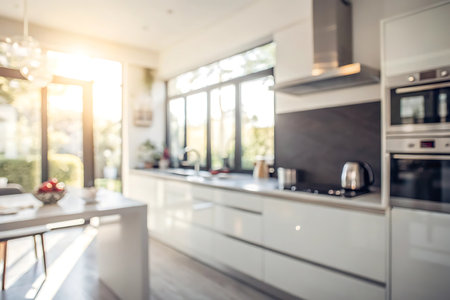Introduction: Why Natural Light Matters in the Kitchen
In American homes, the kitchen is more than just a place to cook—it’s the heart of daily life, a gathering spot for family and friends, and a space that sets the tone for the entire home. Natural light plays an essential role in shaping this environment. It not only enhances the visual appeal of the kitchen but also influences its functionality and mood. Sunlight brings out the true colors of your cabinetry and countertops, makes food look more appetizing, and creates an inviting atmosphere where everyone wants to linger. Maximizing natural light isn’t just about aesthetics; it’s about making your kitchen feel open, energizing, and truly livable. As we explore the role of natural light in kitchen design, we’ll see how it impacts usability and discover practical ways to let more sunshine into your space.
Designing for Daylight: Key Principles
Natural light is a transformative element in kitchen design, shaping how a space feels and functions. To harness its full potential, understanding the core principles of daylight-centric design is essential. Orientation, window placement, and open layouts play pivotal roles in maximizing sunlight while supporting a fresh, inviting aesthetic.
Orientation Matters
The direction your kitchen faces impacts both the quality and quantity of natural light. North-facing kitchens receive soft, consistent light throughout the day—ideal for reducing glare and maintaining an even ambiance. South-facing spaces enjoy abundant sunshine, perfect for brightening larger areas but may require thoughtful shading solutions. East-facing kitchens are bathed in morning light, energizing early routines, while west-facing rooms capture warm afternoon sun. Consider these factors during planning to align natural light with your daily rhythms.
Window Placement Strategies
Strategic window placement makes all the difference. Large windows on exterior walls invite more daylight, while clerestory or transom windows add height and drama without sacrificing privacy. Skylights can flood the space from above, especially useful in single-story homes or where wall space is limited. Combining different window styles ensures balanced illumination and visual interest.
| Window Type | Best Use | Light Quality |
|---|---|---|
| Picture Windows | Main exterior walls | Wide, unobstructed views; maximum daylight |
| Clerestory Windows | High up on walls | Even overhead light; privacy maintained |
| Skylights | Ceilings or roofline | Direct top-down sunlight; dramatic effect |
| Bay/Bow Windows | Dining nooks or corners | Panoramic light; architectural interest |
The Power of Open Layouts
Open floor plans amplify natural light by eliminating barriers that block sunlight’s path. Removing unnecessary walls lets daylight flow freely through adjoining spaces—making kitchens feel larger and more welcoming. Glass doors connecting to patios or decks create seamless indoor-outdoor transitions and further enhance brightness.
Simplicity in Design Choices
Select minimal window treatments or opt for sheer fabrics to filter light gently without blocking it. Light-colored cabinetry and reflective surfaces like polished stone or glass backsplashes bounce sunlight around the room, elevating the overall sense of openness.
A Thoughtful Approach Brings Results
Intentional choices in orientation, window types, and layout can transform any kitchen into a sunlit retreat. By applying these key principles, you’ll create a space that feels energized by day and effortlessly stylish at any hour.
![]()
3. Window Styles and Their Impact
Choosing the right window style is essential to shaping both the look and light quality of your kitchen. In American homes, certain window types are especially popular for their ability to enhance natural illumination and complement diverse design aesthetics.
Bay Windows: Framing Views, Expanding Light
Bay windows are a classic choice in U.S. kitchens, often installed above breakfast nooks or sinks. Their angled, multi-panel design projects outward, capturing sunlight from multiple directions. This not only floods your kitchen with soft, panoramic light but also visually expands space, creating a cozy alcove perfect for seating or displaying greenery.
Casement Windows: Flexibility Meets Function
Casement windows—hinged at the side and opening outward—are valued for their flexibility and efficiency. A favorite in modern and transitional kitchens, they allow for maximum ventilation and can be strategically placed to direct breezes and daylight deep into your cooking zone. Their clean lines also pair well with minimalist cabinetry and hardware.
Skylights: Bringing in Overhead Sunshine
For kitchens where wall space is limited or privacy is a concern, skylights are a game-changer. These ceiling-mounted windows pour sunlight directly from above, brightening even the darkest layouts. Skylights are especially effective in open-concept homes or galley kitchens, transforming the atmosphere with dynamic shafts of daylight throughout the day.
The Design Takeaway
The style of window you choose doesn’t just affect how much light enters your kitchen—it shapes your daily experience of space, mood, and connection to the outdoors. Whether you opt for the sweeping views of bay windows, the practical elegance of casements, or the drama of skylights, each option offers unique opportunities to maximize natural light while reflecting your personal taste.
4. Materials and Finishes: Amplifying Natural Light
When it comes to kitchen design, the right materials and finishes can transform natural light into a stunning feature. Surfaces that reflect and amplify sunlight not only make your kitchen feel larger and brighter but also elevate its overall style. Here’s how you can use finishes to enhance the natural light in your space:
Reflective Surfaces: The Power Players
Glossy tiles, white cabinetry, and polished countertops act as mirrors, bouncing light around the room. These choices are especially effective in American homes where open-concept kitchens are popular and brightness is key for both function and aesthetics.
Key Materials That Maximize Light
| Material/Finish | Light Enhancement | Design Impact |
|---|---|---|
| White Cabinetry | Reflects the most light, making spaces feel airy and open. | Timeless, clean look; pairs well with any color palette. |
| Glossy Subway Tile | Bounces daylight across walls, enhancing brightness. | Adds texture and a modern edge to classic kitchens. |
| Quartz or Polished Stone Countertops | Shiny surfaces multiply available light on worktops. | Sleek, sophisticated vibe; durable for everyday use. |
| Glass Accents (cabinet doors, shelves) | Allows light to pass through and reflect from multiple angles. | Creates visual openness; perfect for showcasing dishware. |
Pro Tip: Layer Your Finishes
Mixing these elements—like pairing glossy tile with matte wood—creates depth without sacrificing brightness. In U.S. kitchen trends, blending textures keeps the look fresh while ensuring every ray of sunshine counts. By thoughtfully selecting materials that amplify natural light, you not only brighten your kitchen but craft a space that feels both functional and fashion-forward.
5. Balancing Privacy and Sunlight
Natural light brings kitchens to life, but in American homes where neighbors are often close by, privacy matters just as much. Fortunately, you don’t have to compromise one for the other.
Sheer Curtains: Soft Filtering
Lightweight sheer curtains are a timeless solution for letting sunlight pour in while blurring outside views. They add a soft, airy layer that works especially well in open-concept kitchens, keeping the space bright without making it feel exposed.
Frosted Glass: Modern Simplicity
If you prefer something more built-in, frosted or textured glass windows are an elegant option. These allow daylight to filter through beautifully, diffusing harsh glare and creating a calm ambiance—all while maintaining a high level of privacy.
Smart Window Films: Flexible Solutions
For tech-savvy homeowners, smart window films offer the best of both worlds. These innovative films can switch from clear to opaque with the touch of a button or via an app, giving you total control over privacy and natural light throughout the day.
Design Philosophy: Intentional Layers
Balancing sunlight and privacy is about layering thoughtful solutions. By combining sheers, frosted panels, or smart technology, your kitchen can stay luminous and comfortable—reflecting both your design taste and your lifestyle needs.
6. Maximizing Light in Small or Low-Light Kitchens
Designing a kitchen in a compact space or an area with limited natural light can be a challenge, but it’s also an opportunity to get creative. In American urban homes and apartments—where galley layouts are common—embracing smart solutions can make even the smallest kitchen feel open and inviting. The right strategies not only brighten your space but also enhance its functionality.
Leverage Reflective Surfaces
Mirrors are a designer’s secret weapon for boosting light. Place a mirror on a wall opposite a window or along the length of your galley kitchen to reflect daylight deeper into the room. Mirrored backsplashes or high-gloss cabinet finishes can also amplify whatever natural light is available, creating a sense of depth and airiness.
Incorporate Glass Elements
Swap out solid cabinet doors for glass-fronted ones, or use floating glass shelves to let light flow uninterrupted across your kitchen. Glass doors—whether for upper cabinets or as sliding entryways—keep sightlines open and help diffuse sunlight, making tight spaces feel less confined.
Choose Minimalist Shelving
Minimalist open shelving not only aligns with modern American design sensibilities but also prevents bulky upper cabinets from blocking precious sunlight. Arrange shelves thoughtfully to avoid clutter, displaying everyday essentials and curated décor that reflects light rather than absorbing it.
Optimize Your Layout
For galley kitchens, keep counters clear and opt for lighter finishes on walls and cabinetry. Position workspaces near windows when possible, and keep taller storage elements at the ends of the kitchen instead of by the windows to prevent shadows.
The Takeaway
No matter the size or location of your kitchen, maximizing natural light is about thoughtful choices. With mirrors, glass details, and minimalist shelving, you can turn even the most modest urban kitchen into a bright, uplifting space where style meets function.
7. Conclusion: Natural Light as a Design Statement
Embracing natural light in kitchen design is more than just a practical choice—it’s a statement of style and well-being. When sunlight floods your kitchen, it transforms the ordinary into something extraordinary, creating a space that feels open, inviting, and alive. Thoughtful use of windows, skylights, and reflective surfaces can turn the kitchen into the heart of the home, where design meets daily life seamlessly. By maximizing natural light, you not only boost energy efficiency and comfort but also elevate everyday rituals like morning coffee or family dinners. In today’s American homes, letting in the sunshine is a timeless trend that connects us to nature, uplifts our mood, and sets the stage for lasting memories. Let natural light be your signature design element—simple, stylish, and essential.


